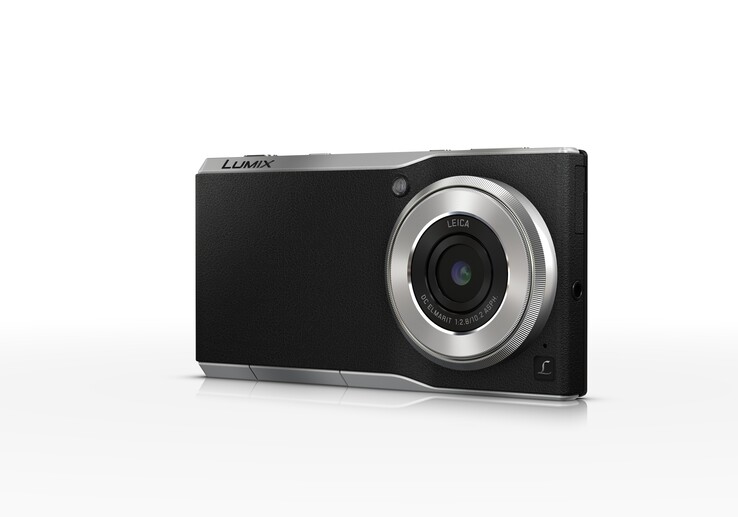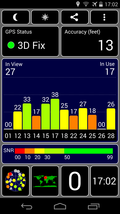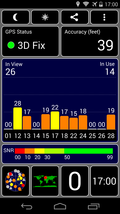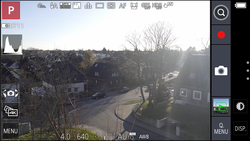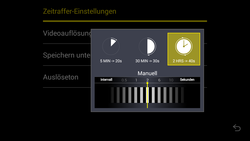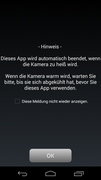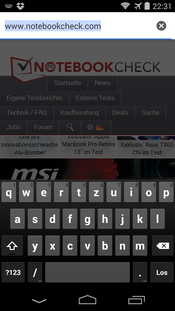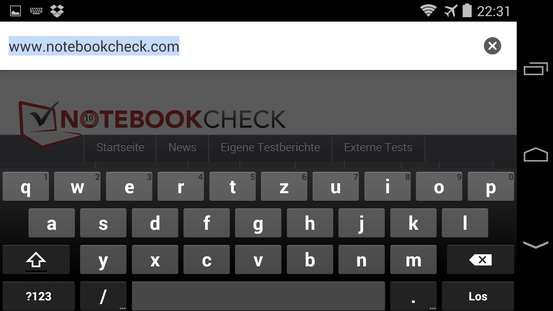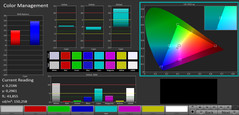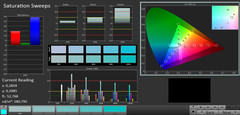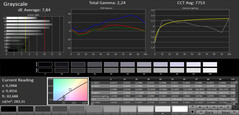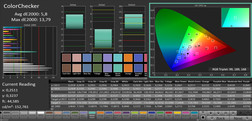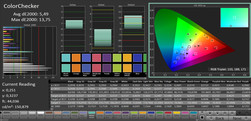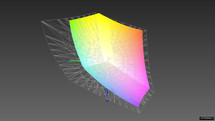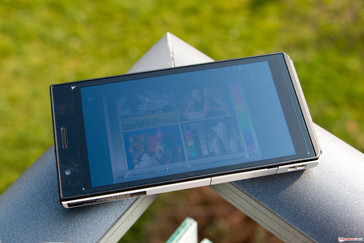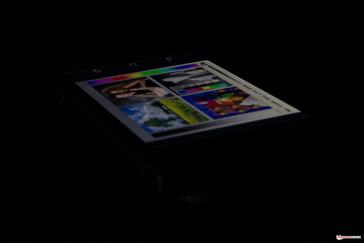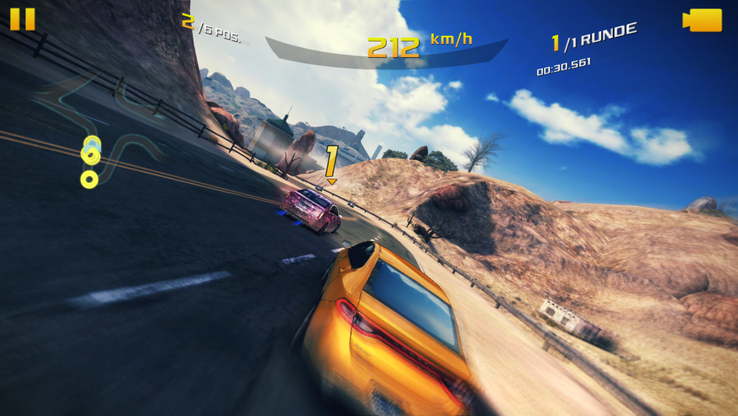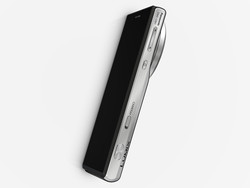Panasonic Lumix DMC-CM1 Smartcam Review

For the original German review, see here.
The camera in Panasonic's Lumix DMC-CM1 not only looks striking, it also has quite a bit to offer according to the spec sheet. With a 1-inch wide sensor, the smartphone has the biggest image sensor in a mobile end device. However, the other equipment is just as impressive. 2 GB of working memory supports the Snapdragon 801. High-speed LTE and a 4.7-inch HD screen round off the bundle. The manufacturer sets up a rather exorbitant price of 899 Euros (~$953).
Case
Panasonic's Lumix DMC-CM1 is a small brick. Its height of 21.1 millimeters is twice that of Nokia's Lumia 1020, which also features a prominent camera. It is also relatively heavy with a weight of 203 grams.
However, the smartphone's mass makes it stiff, and it only crackles a little in corresponding attempts. The review sample is also pressure resistant; at most strong pressure on the screen itself leads to wave formation.
The battery in the Lumix DMC-CM1 is non-removable. Although its interfaces and slots are hidden behind thick flaps, it is not IP certified.
Connectivity
The micro-USB 2.0 port in Panasonic's Lumix DMC-CM1 is only meant for recharging the smartphone and sharing data with a computer. It does not support either MHL or OTG so that the port cannot be used for image output or connecting external peripherals.
The smart-cam can render media via DLNA and Miracast wirelessly. The micro-SD card slot supports memory cards with a capacity of up to 128 GB.
Software
The manufacturer relies on Google's Android 4.4.4 operating system in its Panasonic Lumix DMC-CM1. The user interface has only been modified marginally. In addition to a proprietary time-lapse app, there are also multiple applications for camera control. An update to Android 5.0 Lollipop has been announced for May 2015.
Communication & GPS
Panasonic's Lumix DMC-CM1 connects to the Internet via HSPA+ (max. 42 Mbps) or LTE Cat. 4 (max. 150 Mbps) on-the-go. The wide-ranging frequency coverage should always enable good reception.
The Wi-Fi module supports the IEEE 802.11 a/b/g/n/ac standards and thus transmits in both the 2.4 and 5.0 GHz frequency bands. The range is average and should be enough to get by.
The Lumix utilizes both the GPS and Glonass networks for localization. Tracking took a very long time although there were enough satellites available in the building, and it was not very accurate. It was considerably faster and more accurate outdoors.
Telephone & Voice Quality
The voice quality of Panasonic's Lumix DMC-CM1 is quite decent, but audible losses have to be accepted compared with other smartphones from this price range. Although the contact is well intelligible, the voice is never really clear. The voice of the smart-cam user also sounds slightly distorted.
Cameras
The front-facing camera has a maximum resolution of 2 MP and shoots relatively decent pictures. It still manages to capture a surprising amount of residual light in low-light conditions. However, that also leads to minor artifacts and visible noise.
The showpiece of the smart-cam is the primary camera that features 20 MP. It has a 1-inch MOS sensor and a focal length of 28 mm. The aperture can be set from f/2.8 to f/11 manually or it is left up to the automatic settings. The light sensitivity ranges up to ISO 25600. The settings for the Lumix are extremely multiple, but the menus are a bit intricate so that only the fewest features are quick and easy to access. However, they are all the more diverse and offer all features of a first-rate compact camera. The f-stop can be set manually just like the shutter speeds or the selected scene mode. The lens ring is used for quickly switching within the selected mode. Furthermore, the Lumix DMC-CM1 has a panorama feature, a level, a histogram, a semi-automatic, and many more things. The available RAW mode will be interesting for enthusiastic photographers as it promises the lowest possible loss of image material in post-processing.
The image center is extremely focused in pictures, but the sharpness declines slightly toward the edges. Nevertheless, the given image quality is quite amazing for a smartphone and can also convince in terms of color accuracy. The high light sensitivity enables shooting decent pictures in low-light even if the camera loses sharpness toward the edges much sooner. The Lumia 1020 does a considerably better job here. Using the flash is not really advisable here because it strongly distorts the colors.
In addition to a digital x4 zoom, the Lumix DMC-CM1 can also score with an optical zoom (x2). The optical version can be quite useful. However, the pictures are not really focused when using the digital zoom.
We found the temperature warning from the CM1 a bit strange when we started the camera app the first time. Here, the manufacturer warns about overheating the camera, which would stop the app and require patience until the camera cools down before it is ready for use again. We did not have any problems with that during the test, but it might look very different in the summer.
This will likely primarily apply to Ultra HD video recordings that the smartphone also supports. However, since they are not particularly good, it should rarely cause problems in practice. The high-resolution videos are only recorded with 15 frames per second, which does not allow a smooth playback. The available video quality is acceptable otherwise.
Accessories & Warranty
The Lumix DMC-CM1 is only shipped with a comparatively huge power supply. The manufacturer includes a 24-month warranty on its product.
Input Devices & Controls
The capacitive touchscreen in Panasonic's Lumix DMC-CM1 responds very well and quickly to inputs. The surface's gliding qualities are also good and do not give any reasons for complaint.
The virtual keyboard utilizes the stock Android layout. It is very clearly arranged and has an extra row with word suggestions. Other layouts can be installed when preferred.
It is handy that the Lumix not only has a dedicated camera button but also a small slider to directly open the camera app. That once again makes it obvious that the focus is clearly set on photography.
Display
The screen in Panasonic's Lumix DMC-CM1 has a size of 4.7-inches and a resolution of 1920x1080 pixels (Full HD). That equals an aspect ratio of 16:9 and a pixel density of approximately 469 ppi, which ensures razor-sharp reproduction of images.
The maximum brightness of 349 cd/m² is not exceptionally high but should suffice for most scenarios. Although the brightness is distributed decently it is not outstanding.
| |||||||||||||||||||||||||
Brightness Distribution: 87 %
Center on Battery: 337 cd/m²
Contrast: 864:1 (Black: 0.39 cd/m²)
ΔE Color 5.49 | 0.5-29.43 Ø5
ΔE Greyscale 7.84 | 0.57-98 Ø5.3
63% AdobeRGB 1998 (Argyll 1.6.3 3D)
Gamma: 2.24
| Panasonic Lumix DMC-CM1 Adreno 330, 801 MSM8974AB, 16 GB eMMC Flash | Sony Xperia Z3 Compact Adreno 330, 801 MSM8974AC, 16 GB eMMC Flash | Apple iPhone 6 PowerVR GX6450, A8, 128 GB eMMC Flash | Nokia Lumia 1020 Adreno 225, S4 Plus MSM8960, 32 GB SSD | Nokia Lumia 930 Adreno 330, 800 MSM8974, 32 GB eMMC Flash | LG G3 Adreno 330, 801 MSM8974AC, 16 GB eMMC Flash | |
|---|---|---|---|---|---|---|
| Screen | 10% | 18% | 475% | -27% | -16% | |
| Brightness middle | 337 | 513 52% | 520 54% | 283 -16% | 275 -18% | 417 24% |
| Brightness | 328 | 500 52% | 511 56% | 288 -12% | 278 -15% | 395 20% |
| Brightness Distribution | 87 | 94 8% | 88 1% | 88 1% | 89 2% | 89 2% |
| Black Level * | 0.39 | 0.41 -5% | 0.61 -56% | 0.01 97% | 0.96 -146% | |
| Contrast | 864 | 1251 45% | 852 -1% | 28300 3175% | 434 -50% | |
| Colorchecker dE 2000 * | 5.49 | 8.54 -56% | 3.92 29% | 4.83 12% | 10.99 -100% | 5.67 -3% |
| Greyscale dE 2000 * | 7.84 | 9.88 -26% | 4.33 45% | 2.35 70% | 8.29 -6% | 5.66 28% |
| Gamma | 2.24 98% | 3.03 73% | 2.46 89% | 2.27 97% | 2.16 102% | 2.53 87% |
| CCT | 7753 84% | 8659 75% | 7384 88% | 6338 103% | 6731 97% | 7741 84% |
| Color Space (Percent of AdobeRGB 1998) | 63 | 59 -6% |
* ... smaller is better
The black level of 0.39 cd/m² of the Lumix DMC-CM1 is quite good, and black areas in fact look black. That leads to a decent contrast of 864:1, which could have been even better in conjunction with a higher screen brightness.
The smart-cam's screen is, unlike that of the camera, unfortunately, not worthy of reference. The color space coverage of 63% is better than that of other flagship smartphones, but far from the standards set by Samsung or Apple premium-range products. The color accuracy is only middling and a visible bluish cast is seen in the grayscale levels.
Panasonic's Lumix DMC-CM1 looks quite good in outdoor use as long as it is not exposed to direct sunlight. The screen's low brightness is noticed adversely then, and it becomes difficult to recognize anything on the screen. That is particularly annoying when taking pictures outdoors.
The viewing-angle stability is very good. Brightness decreases or color deviations are not visible to the naked eye even in extremely flat viewing angles.
Performance
Panasonic's Lumix DMC-CM1 does not have the fastest SoC with the Snapdragon 801 MSM8974AB, but it is still a really swift upper-range product. The system finds support in 2 GB of working memory. The Qualcomm Adreno 330 ensures a decent graphics acceleration. Although the benchmarks show that the review sample cannot compete with present top devices, it still has plenty of computing power. The browser speed is also impressive. There is nothing to complain about seen just subjectively.
The 16 GB storage is sufficiently sized but exhibited slight weaknesses in the read speed tests. It is possible to expand the storage by up to 128 GB should more capacity be required.
| Geekbench 3 | |
| 32 Bit Single-Core Score (sort by value) | |
| Panasonic Lumix DMC-CM1 | |
| LG G3 | |
| HTC One M9 | |
| Google Nexus 6 | |
| Apple iPhone 6 | |
| Sony Xperia Z3 Compact | |
| 32 Bit Multi-Core Score (sort by value) | |
| Panasonic Lumix DMC-CM1 | |
| LG G3 | |
| HTC One M9 | |
| Google Nexus 6 | |
| Apple iPhone 6 | |
| Sony Xperia Z3 Compact | |
| 3DMark | |
| 1280x720 offscreen Ice Storm Unlimited Score (sort by value) | |
| Panasonic Lumix DMC-CM1 | |
| LG G3 | |
| HTC One M9 | |
| Google Nexus 6 | |
| Apple iPhone 6 | |
| Sony Xperia Z3 Compact | |
| 1280x720 offscreen Ice Storm Unlimited Graphics Score (sort by value) | |
| Panasonic Lumix DMC-CM1 | |
| LG G3 | |
| HTC One M9 | |
| Google Nexus 6 | |
| Apple iPhone 6 | |
| Sony Xperia Z3 Compact | |
| 1280x720 offscreen Ice Storm Unlimited Physics (sort by value) | |
| Panasonic Lumix DMC-CM1 | |
| LG G3 | |
| HTC One M9 | |
| Google Nexus 6 | |
| Apple iPhone 6 | |
| Sony Xperia Z3 Compact | |
| GFXBench 3.0 | |
| on screen Manhattan Onscreen OGL (sort by value) | |
| Panasonic Lumix DMC-CM1 | |
| LG G3 | |
| HTC One M9 | |
| Google Nexus 6 | |
| Apple iPhone 6 | |
| Sony Xperia Z3 Compact | |
| 1920x1080 1080p Manhattan Offscreen (sort by value) | |
| Panasonic Lumix DMC-CM1 | |
| LG G3 | |
| HTC One M9 | |
| Google Nexus 6 | |
| Apple iPhone 6 | |
| Sony Xperia Z3 Compact | |
| Smartbench 2012 | |
| Productivity Index (sort by value) | |
| LG G3 | |
| HTC One M9 | |
| Google Nexus 6 | |
| Sony Xperia Z3 Compact | |
| Gaming Index (sort by value) | |
| LG G3 | |
| HTC One M9 | |
| Google Nexus 6 | |
| Sony Xperia Z3 Compact | |
| AnTuTu v5 - Total Score (sort by value) | |
| Panasonic Lumix DMC-CM1 | |
| LG G3 | |
| HTC One M9 | |
| Google Nexus 6 | |
| Apple iPhone 6 | |
| Sony Xperia Z3 Compact | |
| AndroBench 3-5 | |
| Sequential Read 256KB (sort by value) | |
| Panasonic Lumix DMC-CM1 | |
| LG G3 | |
| HTC One M9 | |
| Google Nexus 6 | |
| Sony Xperia Z3 Compact | |
| Sequential Write 256KB (sort by value) | |
| Panasonic Lumix DMC-CM1 | |
| LG G3 | |
| HTC One M9 | |
| Google Nexus 6 | |
| Sony Xperia Z3 Compact | |
| Random Read 4KB (sort by value) | |
| Panasonic Lumix DMC-CM1 | |
| LG G3 | |
| HTC One M9 | |
| Google Nexus 6 | |
| Sony Xperia Z3 Compact | |
| Random Write 4KB (sort by value) | |
| Panasonic Lumix DMC-CM1 | |
| LG G3 | |
| HTC One M9 | |
| Google Nexus 6 | |
| Sony Xperia Z3 Compact | |
| Octane V2 - Total Score (sort by value) | |
| Panasonic Lumix DMC-CM1 | |
| LG G3 | |
| LG G3 | |
| HTC One M9 | |
| Google Nexus 6 | |
| Apple iPhone 6 | |
| Nokia Lumia 930 | |
| Sony Xperia Z3 Compact | |
| Mozilla Kraken 1.1 - Total (sort by value) | |
| Panasonic Lumix DMC-CM1 | |
| LG G3 | |
| LG G3 | |
| HTC One M9 | |
| Google Nexus 6 | |
| Apple iPhone 6 | |
| Nokia Lumia 930 | |
| Sony Xperia Z3 Compact | |
| Sunspider - 1.0 Total Score (sort by value) | |
| Panasonic Lumix DMC-CM1 | |
| LG G3 | |
| LG G3 | |
| HTC One M9 | |
| Google Nexus 6 | |
| Apple iPhone 6 | |
| Nokia Lumia 930 | |
| Sony Xperia Z3 Compact | |
* ... smaller is better
Games
A Full HD screen, a speedy graphics unit, and a superb touchscreen let the hearts of gamers beat faster even in more graphically demanding titles. The Adreno 330 still has a lot of performance potential that only a few games in the Play Store can exhaust. The impeccably working sensors also increase the gaming fun.
Emissions
Temperature
Panasonic's Lumix DMC-CM1 reached a maximum of 33.5 °C in idle mode, which is not even lukewarm. That looks different in load, where the surface temperatures reached over 40 °C across the board, and even up to 45.6 °C in some places. Although that is not yet critical, it is pretty high. Thus, it is not surprising that the camera tends to overheat in high temperatures.
(±) The maximum temperature on the upper side is 43.4 °C / 110 F, compared to the average of 35 °C / 95 F, ranging from 21.9 to 56 °C for the class Smartphone.
(-) The bottom heats up to a maximum of 45.6 °C / 114 F, compared to the average of 33.8 °C / 93 F
(+) In idle usage, the average temperature for the upper side is 31.4 °C / 89 F, compared to the device average of 32.7 °C / 91 F.
Speaker
The mono speaker in the Lumix does not have an ideal position and is quickly covered in landscape mode. The sound is only mediocre and not really convincing. Mids and bass are barely if at all audible, and the trebles are tinny and overdrive to such an extent that they hurt the ears in maximum volume. The audio jack makes a good impression. Consequently, headphones or an external speaker should be used when listening to music or watching movies with the smart-cam.
Energy Management
Power Consumption
The power consumption of Panasonic's Lumix DMC-CM1 is quite good when it is in use. However, both the off and standby consumption is slightly increased, and the smartphone depletes itself within a few days without further action.
The power supply's dimensions are gigantic and quite heavy with 131 grams. It supports Quick Charge, but that is not noticed when recharging the Lumix. Over two-and-a-half hours is needed to completely recharge the battery. Furthermore, the battery also discharges during load when the device is connected to the power supply.
| Off / Standby | |
| Idle | |
| Load |
|
Battery Runtime
The 2600 mAh battery in Panasonic's Lumix DMC-CM1 ensures practical runtimes. However, they are not really good. Most contenders last considerably longer in browsing via Wi-Fi. Nevertheless, the battery should manage a day when the camera is not used excessively. It extremely increases the energy requirement, particularly when shooting videos. The time-lapse video in our test depleted 70% of the battery's reserves. Users who want to take the CM1 on a safari should thus have a strong secondary battery in their bag.
| Panasonic Lumix DMC-CM1 Adreno 330, 801 MSM8974AB, 16 GB eMMC Flash | LG G3 Adreno 330, 801 MSM8974AC, 16 GB eMMC Flash | Nokia Lumia 930 Adreno 330, 800 MSM8974, 32 GB eMMC Flash | Apple iPhone 6 PowerVR GX6450, A8, 128 GB eMMC Flash | Sony Xperia Z3 Compact Adreno 330, 801 MSM8974AC, 16 GB eMMC Flash | |
|---|---|---|---|---|---|
| Battery Runtime | |||||
| WiFi v1.3 | 409 | ||||
| WiFi | 452 | 1002 | 530 | 1326 |
Pros
Cons
Verdict
Panasonic's Lumix DMC-CM1 has a very good camera that is rounded off well with the integrated smartphone. The Full HD screen could surely be a bit brighter but makes a good impression otherwise. High-speed LTE and other, modern transmission standards allow the user to share content or render it on external devices easily and without massive delays.
The review sample's phone qualities are rather mediocre, and the speaker can be used as a torture instrument in single pitches. Furthermore, the Lumix exhibits weaknesses in Ultra HD recordings. Only 15 fps is simply too little.
A strong camera, high-speed LTE and a high-resolution screen turn the Lumix DMC-CM1 into a versatile smart-cam. However, the temperature development and the middling battery life mar the overall impression.
Buyers prepared to spend approximately 900 Euros (~$954) on the Lumix DMC-CM1 will get a very good compact camera that can also be used as a smartphone. Anyone looking for a smartphone with a decent camera should also take a look at the competition. Some are better in low-light conditions and can even record Ultra HD videos smoothly.
Panasonic Lumix DMC-CM1
-
04/01/2015 v4(old)
Daniel Schmidt


 Deutsch
Deutsch English
English Español
Español Français
Français Italiano
Italiano Nederlands
Nederlands Polski
Polski Português
Português Русский
Русский Türkçe
Türkçe Svenska
Svenska Chinese
Chinese Magyar
Magyar